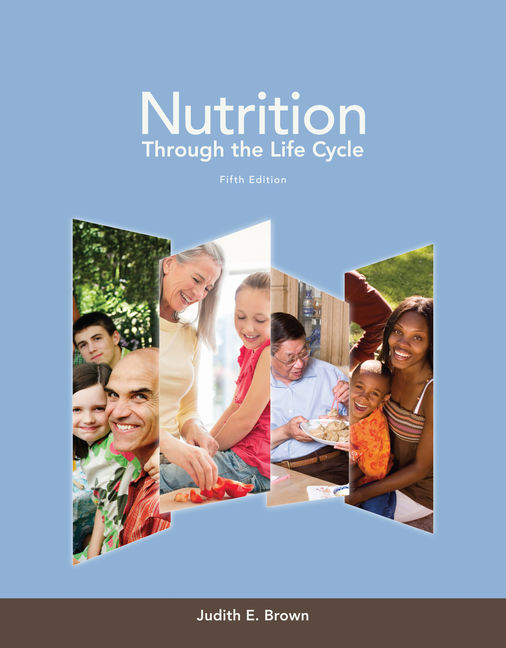Test Bank For Nutrition Through the Life Cycle 5th Edition by Judith E. Brown
Digital item No Waiting Time Instant DownloadISBN-10: 1133600492, ISBN-13: 9781133600497
In Stock
Original price was: $75.00.$35.00Current price is: $35.00.
Test Bank For Nutrition Through the Life Cycle 5th Edition by Judith E. Brown
Test Bank for Chapter 2 – Preconception Nutrition
Key to question information: ANS = correct answer; DIF = question difficulty; REF = page reference; OBJ = chapter learning objective for question section
Learning Objectives
2.1 Cite three examples of the Healthy People 2020 nutrition-related objectives for the preconception period.
2.2 Identify six major hormones involved in the regulation of male and female fertility processes, and identify their source and effects on the regulation of fertility processes.
2.3 Describe the potential effects of nutrition-related factors such as body fat content, iron status, and alcohol intake on fertility in females and males.
2.4 Cite four examples of relationships between nutrient intake and nutritional status during the periconceptional period and the outcome of pregnancy.
2.5 Develop a one-day menu for a preconception woman and a man based on the ChooseMyPlate.gov food guidance materials.
2.6 Identify three nutrition-related consequences that may be related to the use of combination hormonal contraceptives and a consequence that is related to the use of estrogen or progestin contraceptives only.
2.7 Cite three important nutrition-related components of preconception health care.
2.8 Describe the four steps of the Nutrition Care Process.
Multiple Choice
1. Fertility refers to _____.
a. the biological ability to bear children after intercourse
b. the absence of production of children
c. the actual production of children
d. the number of births per 1000 miscarriages
ANS: c DIF: Fact-based, easy REF: 51 OBJ: 2.1
2. Couples having regular, unprotected intercourse have a _____ chance of a diagnosed pregnancy within a given menstrual cycle.
a. 15-20%
b. 20-25%
c. 25-30%
d. 30-50%
e. 50-75%
ANS: b DIF: Fact-based, easy REF: 51 OBJ: 2.1
3. The _____ of the menstrual cycle occurs after ovulation.
a. follicular phase
b. luteal phase
c. estrogen phase
d. primordial phase
e. None of the above
ANS: b DIF: Fact-based, easy REF: 54 OBJ: 2.2
4. What is the rate of miscarriages in the first 20 weeks of pregnancy?
a. 6%
b. 7%
c. 8%
d. 9%
ANS: d DIF: Fact-based, medium REF: 51 OBJ: 2.1
5. The most common cause of miscarriage for women is:
a. structural abnormalities in the uterus.
b. the presence of a severe defect in the fetus.
c. maternal infection.
d. endocrine disorders.
e. unknown random events.
ANS: b DIF: Fact-based REF: 51 OBJ: 2.1
6. The first half of the menstrual cycle is called the _____.
a. follicular phase
b. luteal phase
c. estrogen phase
d. primordial phase
e. None of the above
ANS: a DIF: Fact-based, medium REF: 52 OBJ: 2.2
7. Ovulation results from a surge in the hormone _____.
a. estrogen
b. progesterone
c. luteinizing hormone
d. follicle-stimulating hormone
e. gonadotropin releasing hormone
ANS: c DIF: Fact-based REF: 52 OBJ: 2.2
8. The two hormones secreted by the pituitary gland during the FOLLICULAR phase of a woman’s cycle are:
a. follicle-stimulating hormone and progesterone.
b. progesterone and estrogen.
c. follicle-stimulating hormone and luteinizing hormone.
d. luteinizing hormone and progesterone.
e. luteinizing hormone and estrogen.
ANS: c DIF: Fact-based REF: 52 OBJ: 2.2
9. What hormone triggers the production of testosterone by the testes?
a. Follicle-stimulating hormone
b. Luteinizing hormone
c. Progesterone
d. Estrogen
e. a and b
f. c and d
ANS: e DIF: Fact-based, hard REF: 55 OBJ: 2.2
10. Endometriosis is defined as:
a. scarring and blockage of the fallopian tubes.
b. the condition in which endometrial tissue becomes embedded within other body tissues.
c. a modification of pregnancy hormones that results in infertility.
d. an infection of the cervix.
e. the inability to get pregnant.
ANS: b DIF: Fact-based REF: 56 OBJ: 2.2


Reviews
There are no reviews yet.